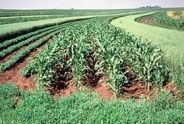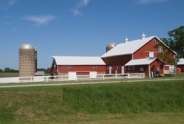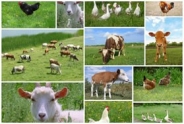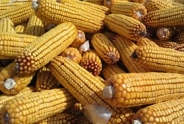Field Nitrogen Balances for Corn Silage
Introduction
A field nutrient balance is an end-of-season evaluation tool defined as the difference between nutrients accessible for crop uptake (nutrient supply), and nutrients removed with forage harvest (nutrient uptake). A large positive balance (excess) signals inefficient use of inputs (including fertilizer and manure), elevated risk of nutrient loss to the environment and/or accumulation in soil over time. Tracking field balances, especially for nitrogen (Figure 1) can help inform if a change in field nutrient management can be considered without negatively impacting crop yield or quality. This factsheet explains the steps involved in deriving field nitrogen (N) balances for corn silage.
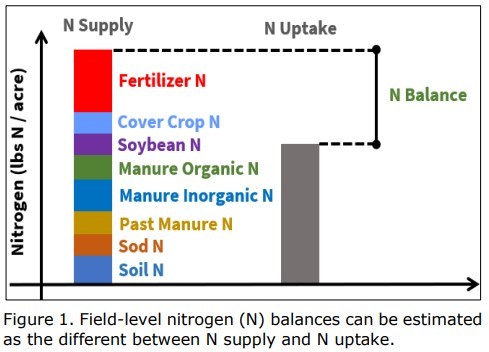
Available versus total N balances
The way manure is managed (application method and timing) impacts the amount of plant-available N we can expect from a specific manure application. More informed decisions can be made when both the total amount of N and N availability are evaluated. Thus, it is important to derive two types of field N balances: (1) available N balance; and (2) total N balance. The total N balance of a given crop year considers the total amount of N applied with manure, independent of timing (e.g. fall or spring) or method of application (surface applied versus incorporated or injected). The available N balance takes into account only the portion of N in the manure that is considered plant available in the year for which the balance is derived (Figure 2).
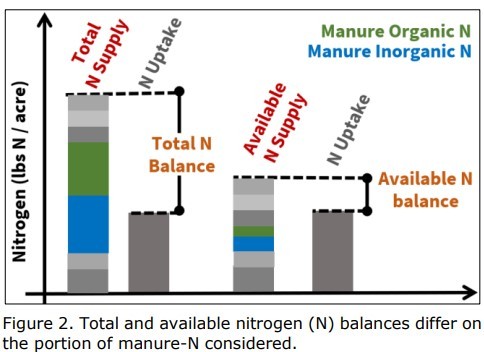
Determining N balances
There are three main steps in determining total and available N balances for a corn silage field.
Step 1: Estimate N uptake per acre
Corn varieties can differ in the amount of N per ton of silage. If reliable forage sample results are available for the field, use the crude protein content listed on the forage report and the following equation to derive the amount of N (lbs N) in a ton of silage (at 35% dry matter):
N per ton=(%CP/100/6.25)*2000*0.35
If field specific data are not available, assume 8.6 lbs N/ton of corn silage (at 35% DM) for short-season hybrids (≤95 days-tomaturity [DTM]) and 8.2 lbs N/ton of corn silage (35% DM) for long-season hybrids (≥96 DTM). If hybrid relative maturity information is not
available, an average of 8.4 lbs N/ton of corn silage (35% DM) can be used.
Once the total amount of N per ton of silage is determined, multiply this number and the yield per acre (also at 35% DM) to obtain N
uptake per acre for the field.
N uptake per acre=yield (ton/acre)*N/ton
Step 2: Estimate N supplyTo determine N supply, sum the contributions of the following N sources.
NSoil
Soil organic matter can supply 40 to 80 lbs of N/acre annually. The soil's N supplying capacity (Nsoil in lbs N/acre) is a function of soil type and tile drainage. Estimates of soil N supply can be found in Appendix Table 2 of the Nitrogen Guidelines for Field Crops in New York.
NSod
Alfalfa, grass, and mixed alfalfa/grass stands will release N into the soil once they are terminated prior to seeding of corn. The amount
of N expected from a terminated sod varies depending on the percentage of legume in the stand and the number of years that have passed since termination of the stand (Table 1).
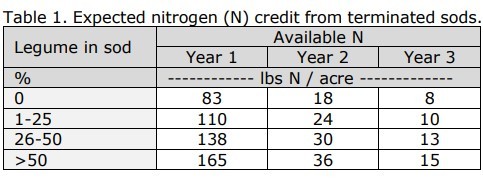
NSoybeans
Corn that follows soybean in a rotation will require less external N than continuous corn. A representative estimate of soybean N credits for corn for N balance assessments is 30 lbs N/acre.
NCoverCrop
Cover crops can also supply N to the crop that follows. The amount of biomass, its N content, and its C:N ratio (maturity) can greatly
influence N dynamics in the soil after termination. A representative estimate of cover crop N credits for corn for use in field N balances
is 30 lbs N/acre. This assumes spring termination of a fall-planted, timely seeded, overwintering cereal grain cover crop such as cereal rye, winter wheat, or triticale.
NManureInorganic, NManureOrganic, NResidualManure
When estimating N supply for total N balances, total organic and inorganic N contributions from manure can be determined by multiplying fieldlevel manure application rates with total N content as listed on the manure analysis. For available N balances, N contributions need to consider when and how manure was applied using Tables 2 and 3. Residual N credits are derived from Table 2 as well.

NFertilizer
Nitrogen contributions from fertilizer are determined by multiplying the application rate and the N content of the material.
Step 3: Estimate available and total N balances
The final field N balances are derived by subtracting N uptake from N supply.
In Summary
Field N balances are end-of-season evaluations to help optimize field N management. Deriving field balances requires assessment of N supply and N uptake using easily obtainable records.
Additional Resources
• Cornell NMSP Agronomy Fact Sheet Series.
http://nmsp.cals.cornell.edu/guidelines/factsheets.html.
Field Nitrogen Balances for Corn Silage (pdf; 178KB)
Upcoming Events
Boots in the Barn: Cornell Dairy Research Updates
January 13, 2026
January 20, 2026
January 27, 2026
February 3, 2026
February 10, 2026
February 17, 2026
February 24, 2026
Join us for some or all!
Advanced Hoof Health Program
January 15, 2026
Belfast, NY
Who should attend?
- Professional hoof trimmers
- Dairy farm owners or managers in charge of farm foot health
Topics include:
- How to Create a Strategic Trimming Program for your Dairy
- The Latest in Lameness Technology for the Dairy Industry
- Housing and Flooring Design: Its Role in Hoof Care
NY Pork Producers Connection Breakfast - Geneseo
January 17, 2026 : Pork Producers Connection Breakfast - Geneseo
Geneseo, NY
All pork producers are invited to join the New York Pork Producers for a free hot farmer's breakfast, at which they'll catch up on topics including the pork to dairy barn conversion series, NYPP digital campaigns, and 840-RFID tags.
Announcements
No announcements at this time.

